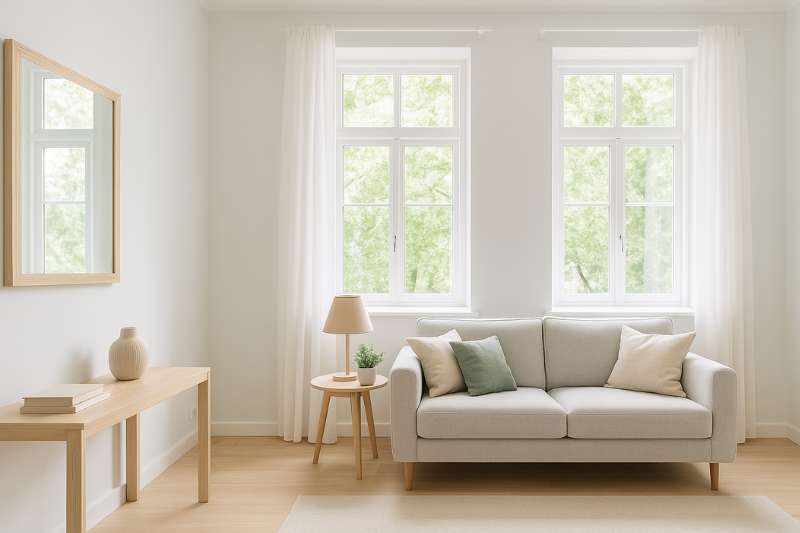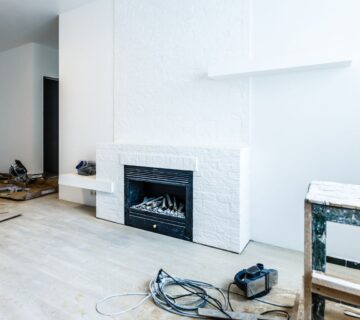Small rooms can feel cramped and dark, but the right paint color can transform them into bright, spacious spaces. Whether it’s a bedroom, hallway, or studio, using the right shades can trick the eye and make your space feel larger. In this guide, we’ll explore the best paint colors for small rooms and how to apply them effectively.
Why Paint Color Matters in Small Rooms
When you want to make a small room appear larger, color is your most powerful tool. Certain paint colors reflect light better, blur edges, and create visual space. The right shades can open up tight corners and low ceilings, making rooms feel more airy, clean, and inviting.
Best Paint Colors for Small Spaces
Soft White: Clean, Bright, and Timeless
White is a go-to for a reason. Soft, warm whites reflect natural light beautifully without feeling sterile. Use it on walls, ceilings, and even trim for a seamless, expansive look. Choose shades like Chantilly Lace or White Dove by Benjamin Moore for a fresh and modern effect.
Pale Gray: Elegant and Versatile
Light gray adds dimension without closing in a room. It pairs well with both warm and cool tones, making it ideal for small bedrooms or offices. Try classic tones like Agreeable Gray or Repose Gray by Sherwin-Williams for a soothing, sophisticated feel that makes walls recede visually.
Cool Blue: Calm and Expansive
Pale blue brings tranquility and brightness to a room. It mimics the sky, giving the illusion of open space. Use it in bathrooms or bedrooms to create a refreshing vibe. Popular choices include Benjamin Moore’s Iceberg or Sherwin-Williams’ Misty—both make a room feel light and airy.
Light Beige or Taupe: Cozy, Yet Open
Beige and taupe provide warmth while keeping a space visually open. These neutrals work well in living rooms, hallways, and basements. They’re especially great if you want something warmer than white. Try colors like Accessible Beige or Edgecomb Gray for a neutral that expands the space without dullness.
Soft Green: Natural and Serene
A gentle green shade—like sage or mint—can give a room a fresh, outdoorsy feel. This color is great for bathrooms, reading nooks, or kitchens. Light green tones reflect daylight and harmonize with plants and wood accents, helping the room feel calm and spacious.
Application Techniques to Enhance Size
Use One Color on Walls and Trim
Painting walls, trim, and doors the same color blurs boundaries and gives a unified look. This trick removes visual breaks and helps a room feel larger. Opt for a slightly different finish—matte for walls and semi-gloss for trim—for subtle contrast that keeps things interesting.
Extend the Ceiling Color Downward
If your ceiling is low, paint the top 6–12 inches of your wall the same color as the ceiling. This creates the illusion of height and makes the ceiling appear higher than it is. It’s a subtle but powerful way to visually expand small vertical spaces.
Use Lighter Shades Throughout
Avoid dark or contrasting accent walls in small rooms. They visually “cut” the space and make walls feel closer together. Instead, stick with lighter shades on all four walls for a more continuous, open appearance. The more uniform the color, the more open the room will feel.
Bonus Design Tips to Maximize the Effect
Let in More Light
Paint color and lighting go hand in hand. To amplify your color’s impact, remove heavy curtains and use sheer window coverings. Also, place mirrors across from windows to reflect light and create more visual space. Good lighting can double the effect of your paint choice.
Choose Matte or Satin Finishes
Shiny finishes can highlight imperfections and make walls feel harsh. For small rooms, use matte or satin paints to diffuse light gently. These finishes reduce glare and give a soft, consistent appearance—making the space feel smoother and more cohesive.
Use Paint to Unify Spaces
In homes with several small rooms, use the same or similar color in adjacent areas. This visual continuity prevents a chopped-up look and makes the overall layout feel larger. Slight variations of a single base color can also work if you want subtle diversity without breaking the flow.
Conclusion
The right paint colors can completely transform small spaces. Soft whites, pale grays, cool blues, and gentle greens are your allies in creating brighter, more open rooms. Combined with smart application techniques and light-enhancing design, these shades help you maximize space without changing the floor plan.
✅ Need help choosing the perfect color for your small space? Contact Lopez Chavarria Construction today for expert painting services and remodeling solutions that elevate every room.






No comment